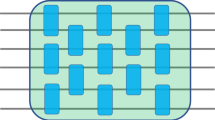Abstract
Composite systems consisting of a large number of similar subsystems play an important role in many areas of physics as well as in information theory. Their analysis, however, often relies on the assumption that the subsystems are mutually independent (or only weakly correlated). Here, we show that this assumption is generally justified for quantum systems that are symmetric, that is, invariant under permutations of the subsystems. Because symmetry is often implied by natural properties, for example, the indistinguishability of identical particles, the result has a wide range of consequences. In particular, it implies that global properties of a large composite system can be estimated by measurements applied to a limited number of (randomly chosen) sample subsystems, a fact that is important for the interpretation of experimental data. Moreover, it generalizes statements in quantum information theory and cryptography, which previously have only been known to hold under certain independence assumptions.
This is a preview of subscription content, access via your institution
Access options
Subscribe to this journal
Receive 12 print issues and online access
$209.00 per year
only $17.42 per issue
Buy this article
- Purchase on Springer Link
- Instant access to full article PDF
Prices may be subject to local taxes which are calculated during checkout




Similar content being viewed by others
References
de Finetti, B. La prévision: Ses lois logiques, ses sources subjectives. Ann. Inst. H. Poincaré 7, 1–68 (1937).
Monari, P. & Cocchi, D. (eds) Introduction to Bruno de Finetti’s “Probabilià e Induzione” (Cooperativa Libraria Universitaria Editrice, Bologna, 1993).
Diaconis, P. & Freedman, D. Finite exchangeable sequences. Ann. Probab. 8, 745–764 (1980).
Størmer, E. Symmetric states of infinite tensor products of C*-algebras. J. Funct. Anal. 3, 48–68 (1969).
Hudson, R. L. & Moody, G. R. Locally normal symmetric states and an analogue of de Finetti’s theorem. Z. Wahrschein. verw. Geb. 33, 343–351 (1976).
Fannes, M., Lewis, J. T. & Verbeure, A. Symmetric states of composite systems. Lett. Math. Phys. 15, 255–260 (1988).
Raggio, G. A. & Werner, R. F. Quantum statistical mechanics of general mean field systems. Helv. Phys. Acta 62, 980–1003 (1989).
Petz, D. A de Finetti-type theorem with m-dependent states. Probab. Theory Related Fields 85, 65–72 (1990).
Caves, C. M., Fuchs, C. A. & Schack, R. Unknown quantum states: The quantum de Finetti representation. J. Math. Phys. 43, 4537–4559 (2002).
König, R. & Renner, R. A de Finetti representation for finite symmetric quantum states. J. Math. Phys. 46, 122108 (2005).
Christandl, M., König, R., Mitchison, G. & Renner, R. One-and-a-half quantum de Finetti theorems. Comm. Math. Phys. 273, 473–498 (2007).
D’Cruz, C., Osborne, T. J. & Schack, R. Finite de Finetti theorem for infinite-dimensional systems. Phys. Rev. Lett. 98, 160406 (2007).
Fuchs, C. A., Schack, R. & Scudo, P. F. De Finetti representation theorem for quantum process tomography. Phys. Rev. A 69, 062305 (2004).
Reed, M. & Simon, B. Methods in Modern Mathematical Physics Vol. 1 (Academic, New York, 1972).
Bennett, C. H. & Brassard, G. Proc. IEEE Int. Conf. on Computers, Systems and Signal Processing 175–179 (IEEE Computer Society, New York, 1984).
Ekert, A. K. Quantum cryptography based on Bell’s theorem. Phys. Rev. Lett. 67, 661–663 (1991).
Bennett, C. H., Brassard, G. & Mermin, N. D. Quantum cryptography without Bell’s theorem. Phys. Rev. Lett. 68, 557–559 (1992).
Mayers, D. Unconditional security in quantum cryptography. J. ACM 48, 351–406 (2001).
Lo, H.-K. & Chau, H. F. Unconditional security of quantum key distribution over arbitrarily long distances. Science 283, 2050–2056 (1999).
Shor, P. W. & Preskill, J. Simple proof of security of the BB84 quantum key distribution protocol. Phys. Rev. Lett. 85, 441–444 (2000).
Biham, E. & Mor, T. Security of quantum cryptography against collective attacks. Phys. Rev. Lett. 78, 2256–2259 (1997).
Biham, E., Boyer, M., Brassard, G., van de Graaf, J. & Mor, T. Security of quantum key distribution against all collective attacks. Algorithmica 34, 372–388 (2002).
Devetak, I. & Winter, A. Distillation of secret key and entanglement from quantum states. Proc. R. Soc. Lond. A 461, 207–235 (2005).
Renner, R. Security of Quantum Key Distribution. Thesis, Swiss Federal Institute of Technology (ETH) Zurich (2005).
Fannes, M., Spohn, H. & Verbeure, A. Equilibrium states for mean field models. J. Math. Phys. 21, 355–358 (1980).
Koenig, R. & Mitchison, G. A most compendious and facile quantum de Finetti theorem. Preprint at <http://arxiv.org/abs/quant-ph/0703210v1> (2007).
Hudson, R. L. Analogs of de Finetti’s theorem and interpretative problems of quantum mechanics. Found. Phys. 11, 805–808 (1981).
Brassard, G. Is information the key? Nature Phys. 1, 2–4 (2005).
Acknowledgements
I thank C. Bennett, M. Christandl, R. Colbeck, A. Ekert, R. König, U. Maurer and G. Mitchison for their helpful comments on earlier versions of the manuscript. This research was supported by HP Labs Bristol and by the EU through the project SECOQC. Parts of this work have been accomplished while the author was at ETH Zurich.
Author information
Authors and Affiliations
Corresponding author
Ethics declarations
Competing interests
The author declares no competing financial interests.
Supplementary information
Rights and permissions
About this article
Cite this article
Renner, R. Symmetry of large physical systems implies independence of subsystems. Nature Phys 3, 645–649 (2007). https://doi.org/10.1038/nphys684
Received:
Accepted:
Published:
Issue Date:
DOI: https://doi.org/10.1038/nphys684
This article is cited by
-
Circular mediated semi-quantum key distribution
Quantum Information Processing (2023)
-
Beyond islands: a free probabilistic approach
Journal of High Energy Physics (2023)
-
A Convergent Inflation Hierarchy for Quantum Causal Structures
Communications in Mathematical Physics (2023)
-
Security analysis for single-state circular mediated semi-quantum key distribution
Quantum Information Processing (2023)
-
Measurement device–independent quantum secure direct communication with user authentication
Quantum Information Processing (2022)



